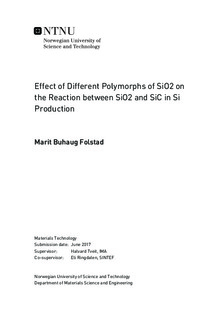Effect of Different Polymorphs of SiO2 on the Reaction between SiO2 and SiC in Si Production
Master thesis
Permanent lenke
http://hdl.handle.net/11250/2453816Utgivelsesdato
2017Metadata
Vis full innførselSamlinger
Sammendrag
The aim of this work have been to investigate the phase transformations in silica (SiO2) during heating to target temperature, and the effect of SiO2 polymorphs on the reduction reaction between SiO2 and silicon carbide (SiC) in silicon production. This is done as a step to get a better understanding and to improve the furnace operations of the silicon process. Earlier studies have found no difference in effect of quartz and cristobalite on the reduction reaction. The effect of amorphous silica is therefore especially of interest in this study. The goals of this thesis have been investigated by performing
Non-isothermal furnace experiments with different heating rates to study the phase transformations in SiO2 during heating to target temperature 1700-1900 C. Isothermal furnace experiments with different heating rates to 1700-1900 C to study the effect of SiO2 polymorphs on the reaction rate for the reduction reaction between SiO2 and SiC.
Pellets of Quartz, Qz20 and SiC have been heated and XRD analyses using internal standard method found that several SiO2 phase transformations occurred before target temperature was reached. Both target temperature and heating rate have an impact on amount of SiO2 phases formed during heating. Amorphous silica forms both from -quartz and from softened/molten SiO2, and amount of amorphous silica increased with increasing target temperature. Different heating rates to 1800 C gave a greater variation in amount of amorphous silica than different heating rates to 1700 C. Morphology images found that no visual differences can be observed between the different SiO2 phases.
The different SiO2 polymorphs had no effect on the reduction reaction between SiO2 and SiC. Conversion was measured from the weight loss of the pellets and the method used is found to give reliable results. The conversion increased with increasing temperature from 1700-1900 C. Morphology images found that the remaining pellets after furnace experiments at 1700 C had started to melt, while at 1800 C the remaining samples were completely melted. Melting of SiO2 would expect to give a higher reaction rate as it increases the contact area of the reactants.
